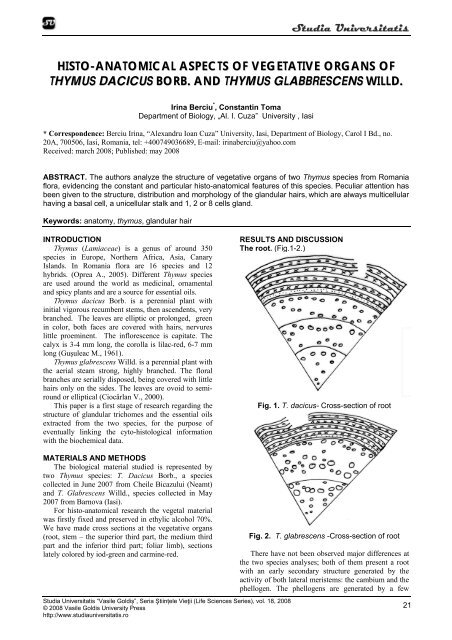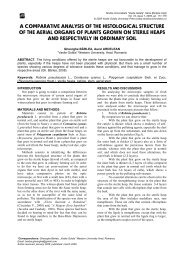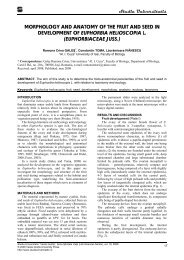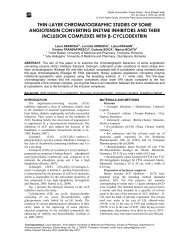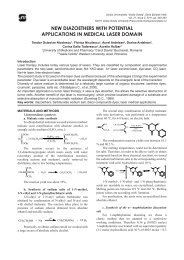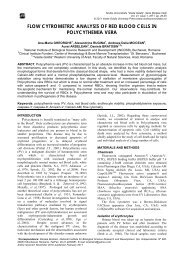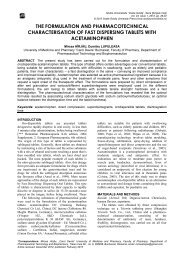histo-anatomical aspects of vegetative organs of thymus dacicus ...
histo-anatomical aspects of vegetative organs of thymus dacicus ...
histo-anatomical aspects of vegetative organs of thymus dacicus ...
Create successful ePaper yourself
Turn your PDF publications into a flip-book with our unique Google optimized e-Paper software.
Studia Universitatis<br />
HISTO-ANATOMICAL ASPECTS OF VEGETATIVE ORGANS OF<br />
THYMUS DACICUS BORB. AND THYMUS GLABBRESCENS WILLD.<br />
Irina Berciu * , Constantin Toma<br />
Department <strong>of</strong> Biology, „Al. I. Cuza” University , Iasi<br />
* Correspondence: Berciu Irina, “Alexandru Ioan Cuza” University, Iasi, Department <strong>of</strong> Biology, Carol I Bd., no.<br />
20A, 700506, Iasi, Romania, tel: +400749036689, E-mail: irinaberciu@yahoo.com<br />
Received: march 2008; Published: may 2008<br />
ABSTRACT. The authors analyze the structure <strong>of</strong> <strong>vegetative</strong> <strong>organs</strong> <strong>of</strong> two Thymus species from Romania<br />
flora, evidencing the constant and particular <strong>histo</strong>-<strong>anatomical</strong> features <strong>of</strong> this species. Peculiar attention has<br />
been given to the structure, distribution and morphology <strong>of</strong> the glandular hairs, which are always multicellular<br />
having a basal cell, a unicellular stalk and 1, 2 or 8 cells gland.<br />
Keywords: anatomy, <strong>thymus</strong>, glandular hair<br />
INTRODUCTION<br />
Thymus (Lamiaceae) is a genus <strong>of</strong> around 350<br />
species in Europe, Northern Africa, Asia, Canary<br />
Islands. In Romania flora are 16 species and 12<br />
hybrids. (Oprea A., 2005). Different Thymus species<br />
are used around the world as medicinal, ornamental<br />
and spicy plants and are a source for essential oils.<br />
Thymus <strong>dacicus</strong> Borb. is a perennial plant with<br />
initial vigorous recumbent stems, then ascendents, very<br />
branched. The leaves are elliptic or prolonged, green<br />
in color, both faces are covered with hairs, nervures<br />
little proeminent. The inflorescence is capitate. The<br />
calyx is 3-4 mm long, the corolla is lilac-red, 6-7 mm<br />
long (Guşuleac M., 1961).<br />
Thymus glabrescens Willd. is a perennial plant with<br />
the aerial steam strong, highly branched. The floral<br />
branches are serially disposed, being covered with little<br />
hairs only on the sides. The leaves are ovoid to semiround<br />
or elliptical (Ciocârlan V., 2000).<br />
This paper is a first stage <strong>of</strong> research regarding the<br />
structure <strong>of</strong> glandular trichomes and the essential oils<br />
extracted from the two species, for the purpose <strong>of</strong><br />
eventually linking the cyto-<strong>histo</strong>logical information<br />
with the biochemical data.<br />
RESULTS AND DISCUSSION<br />
The root. (Fig.1-2.)<br />
Fig. 1. T. <strong>dacicus</strong>- Cross-section <strong>of</strong> root<br />
MATERIALS AND METHODS<br />
The biological material studied is represented by<br />
two Thymus species: T. Dacicus Borb., a species<br />
collected in June 2007 from Cheile Bicazului (Neamt)<br />
and T. Glabrescens Willd., species collected in May<br />
2007 from Barnova (Iasi).<br />
For <strong>histo</strong>-<strong>anatomical</strong> research the vegetal material<br />
was firstly fixed and preserved in ethylic alcohol 70%.<br />
We have made cross sections at the <strong>vegetative</strong> <strong>organs</strong><br />
(root, stem – the superior third part, the medium third<br />
part and the inferior third part; foliar limb), sections<br />
lately colored by iod-green and carmine-red.<br />
Studia Universitatis “Vasile Goldiș”, Seria Ştiințele Vieţii (Life Sciences Series), vol. 18, 2008<br />
© 2008 Vasile Goldis University Press<br />
http://www.studiauniversitatis.ro<br />
Fig. 2. T. glabrescens -Cross-section <strong>of</strong> root<br />
There have not been observed major differences at<br />
the two species analyses; both <strong>of</strong> them present a root<br />
with an early secondary structure generated by the<br />
activity <strong>of</strong> both lateral meristems: the cambium and the<br />
phellogen. The phellogens are generated by a few<br />
21
Studia Universitatis<br />
pr<strong>of</strong>ound cortical layers and form some thin periderms,<br />
the ritidome. First periderms are partial detached and<br />
parts <strong>of</strong> primary cortical parenchyma adhere by de<br />
latest periderm. The cork cells present a radial<br />
disposition and the phellogen cells are tangential<br />
oblongs, with the thin walls.<br />
The central cylinder present a thin secondary,<br />
external phloem ring (consisting in sieved tubes,<br />
companion cells and parenchyma cells) and a few (2-<br />
3) thicker secondary xylem rings, both resulted from<br />
the activity <strong>of</strong> the cambium. Annual rings <strong>of</strong> secondary<br />
xylem are streaky unequal as thickness, every one <strong>of</strong><br />
them having xylem vessels <strong>of</strong> large diameter and less<br />
lately xylem vessels <strong>of</strong> smaller diameter, separeted by<br />
libriform. The xylem parenchima is terminal and is<br />
form by the end <strong>of</strong> each year <strong>of</strong> vegetation.<br />
First two annual rings presents a few vessel with a<br />
smoll diameter and in the center <strong>of</strong> root are a few cells<br />
<strong>of</strong> parenchim moderate thickened. Looking with<br />
attention, in center is distinguishing 3 bundles <strong>of</strong> xylem<br />
from primary structure.<br />
The stem (Fig. 3-8)<br />
In cross section <strong>of</strong> the superior level <strong>of</strong> the stem,<br />
both analyzed species present round ribs. At T. <strong>dacicus</strong><br />
the epidermis presents izodiametric cells, with<br />
thickened internal and external walls, the external wall<br />
being covered by a very thick cuticle. Rarely secretory<br />
trichomes and tector trichomes are present, especially<br />
in the ribs. The tector trichomes are mostly localized<br />
on the ribs; their lengthiness is variable being<br />
formatted on ones or more cells. At T. glabrescens the<br />
epidermis presents isomorphs and izodiametric cells,<br />
with thickened external walls and covered by a very<br />
thick cuticle. From place to place, are present the<br />
stomata, many tector trichomes and secretory<br />
trichomes, mostly with unicellular gland. The tector<br />
trichomes have different lengthiness, being unicellular,<br />
bicellulars or multicellulars.<br />
On both analyzed species, the cortex is<br />
collenchymatised in the ribs and parenchymaticcellulosed<br />
in the rest.<br />
The cortex presents a Casparyan type endodermis,<br />
with large cells, weakly tangentially elongated cells, at<br />
both investigated species.<br />
At T. <strong>dacicus</strong> the central cylinder is thick with<br />
primary structure, but the conducting vessels are<br />
represented by a tenuous external phloem ring<br />
(consisting in sieved tubes and companion cells) and a<br />
thicker xylem ring. Between this two rings there is a<br />
thicker procambium ring (consisting in 3-4 layers). The<br />
pith is thick, parenchymatic-cellulosed, <strong>of</strong> meatus type;<br />
the cells from perimedular aria are moderated<br />
colenchimatouses.<br />
At T. glabrescens the central cylinder present a<br />
particular secondary structure, being formed from a<br />
very tenuous external phloem ring (consisting in sieved<br />
tubes, companion cells and a few parenchyma cells)<br />
and a thicker xylem ring formed mostly by libriform<br />
fibers with external wall very thick and partial<br />
lignified. In the inferior part <strong>of</strong> the xylem ring on<br />
perceive a few xylem vessels that can be solitary or<br />
grouped in cross. The pith is thick, parenchymaticcellulosed,<br />
<strong>of</strong> meatus type; most <strong>of</strong> the cells from<br />
central part being disorganizated or in process <strong>of</strong><br />
disorganization, resulting a big aerifer cavity, with<br />
fitful configuration.<br />
22<br />
Fig. 3. T. <strong>dacicus</strong>-Cross-section <strong>of</strong> stem (superior<br />
level), x400<br />
Fig. 4. T. glabrescens-Cross-section <strong>of</strong> stem (superior<br />
level), x400<br />
In cross section <strong>of</strong> the median level <strong>of</strong> the stem, at<br />
T. <strong>dacicus</strong>, in comparison with superior level, the<br />
cuticle is thicker (especially in ribs); the cortical<br />
parenchyma presents big aerifer cavity and the central<br />
cylinder present a secondary structure being<br />
Studia Universitatis “Vasile Goldiş”, Seria Ştiințele Vieţii (Life Sciences Series), vol. 18, 2008<br />
© 2008 Vasile Goldis University Press<br />
http://www.studiauniversitatis.ro
Studia Universitatis<br />
represented by a tenuous external phloem ring<br />
(consisting in sieved tubes, companion cells and a few<br />
parenchyma cells) and a thicker xylem ring (with<br />
libriform and a few vassels).<br />
At T. glabrescens in median level <strong>of</strong> the stem the<br />
structure is similar with the superior level, with the<br />
followings different: the cuticle is thicker, the tector<br />
hairs are more numerous, the xylem ring presents more<br />
vessels, dispersed in libriform fundamental mass.<br />
In cross section <strong>of</strong> the inferior level <strong>of</strong> the stem, at<br />
T. <strong>dacicus</strong>, the configuration <strong>of</strong> cross section remain<br />
the same with the preceding level, but the ribs are a<br />
little salient. The xylem ring is thicker and the central<br />
aerifer cavity is tighter.<br />
At T. glabrescens the structure remain the same<br />
with the preceding level, with the mention that the<br />
configuration <strong>of</strong> cross section is round and the cuticle<br />
is very thick.<br />
Fig. 5. T. <strong>dacicus</strong>-Cross-section <strong>of</strong> stem (middle level),<br />
x400<br />
Fig. 6. T. glabrescens-Cross-section <strong>of</strong> stem (middle<br />
level), x400<br />
Fig. 7. T. <strong>dacicus</strong>-Cross-section <strong>of</strong> stem (inferior level),<br />
x400<br />
The foliar blade (fig. 9).<br />
At both analyzed species, in front side view, the<br />
epidermis consists <strong>of</strong> irregularly-shaped cells, with<br />
weak waved walls. Both epidermis present stomata <strong>of</strong><br />
diacytic type, so, the limb are amfistomatic. Here and<br />
there a lot <strong>of</strong> secretory and non-secretory (tector)<br />
Fig. 8. T. glabrescens-Cross-section <strong>of</strong> stem (inferior<br />
level), x400<br />
trichomes are present. The borders <strong>of</strong> foliar blade have<br />
practically all cells transformed in aculeiform hairs,<br />
unicellular, with external walls very thick; a few hairs<br />
are multicellular having the terminal cell with blind<br />
apex.<br />
Studia Universitatis “Vasile Goldiș”, Seria Ştiințele Vieţii (Life Sciences Series), vol. 18, 2008<br />
© 2008 Vasile Goldis University Press<br />
http://www.studiauniversitatis.ro<br />
23
Studia Universitatis<br />
Fig. 9 A T. <strong>dacicus</strong>- the lower epidermis <strong>of</strong> the limb<br />
Fig. 9 B T. glabrescens-- the lower epidermis <strong>of</strong> the limb<br />
Fig. 10. Secretory trichomes belonging to T. <strong>dacicus</strong>,<br />
x400<br />
Fig. 11. Secretory trichomes belonging to T.<br />
glabrescens, x400<br />
24<br />
Studia Universitatis “Vasile Goldiş”, Seria Ştiințele Vieţii (Life Sciences Series), vol. 18, 2008<br />
© 2008 Vasile Goldis University Press<br />
http://www.studiauniversitatis.ro
Studia Universitatis<br />
In cross section, at both analyzed species, the<br />
mesophyll is formed by palisade tissue at the upper<br />
side and lacunary tissue at the lower one, so, the blade<br />
has a bifacial-heter<strong>of</strong>acial (dorsiventral) structure.<br />
At T. <strong>dacicus</strong>, the palisade tissue is bistratified,<br />
dense, with the hypodermic layer cells higher and with<br />
winding lateral walls. The lacunary tissue present 5-6<br />
layers by rounded cells or fitful cells, with small aerifer<br />
lacunae between cells. To the border <strong>of</strong> foliar blade<br />
whole the mesophyll is on palisadyc type. The<br />
conducted vessels form more bundles, the biggest one<br />
presents at the periphery <strong>of</strong> the phloem cordons <strong>of</strong><br />
sclerenchymatous fibers, with very thick walls but<br />
moderated lignified.<br />
At T. glabrescens, the palisade tissue is bistratified,<br />
with hypodermic layer cells higher. The lacunary tissue<br />
compass about 4 layers cells, isodiametric or tangent<br />
elongated, with small aerifer lacunas between them.<br />
REFERENCES<br />
Bailey Ciocârlan V., Flora ilustrată a României.<br />
Pteridophyta et Spermatophyta, Ed. Ceres,<br />
Bucureşti, pp. 670-675, 2000;<br />
Guşuleac M., Thymus, In Flora Republicii Populare<br />
Române, VIII, Ed. Acad. RPR, Bucureşti, pp.<br />
301-334, 1961;<br />
Metcalfe C.R., Chalk L., Anatomy <strong>of</strong> Dicotyledons,<br />
Clarendon Press, Oxford, 2, pp. 1041-1053,<br />
1950;<br />
Toma C., Berciu I., Morphological peculiaries <strong>of</strong><br />
germination and structure <strong>of</strong> seedling in<br />
Thymus vulgaris L.; Romanian Biological<br />
Sciences, V, 1-2, pp. 136-137, 2007.<br />
Toma C., Rugină R., Anatomia plantelor medicinale.<br />
Atlas. Ed.Acad. Rom., Bucureşti, pp. 169-172,<br />
1998.<br />
CONCLUSIONS<br />
At both analyzed species, the root presents a<br />
secondary structure, resulting for din activity on both<br />
lateral meristems: the cambium and the fellogen.<br />
On both analyzed species there are two types <strong>of</strong><br />
trichomes: tector trichomes, more <strong>of</strong>ten multicelular,<br />
and secretors trichomes, always multicelular,<br />
consisting in a basal cell, a unicellular pedicel and a<br />
uni- or multicellular gland.<br />
The endoderm <strong>of</strong> Casparyan types became visible<br />
in the median third <strong>of</strong> the T. <strong>dacicus</strong> stem.<br />
At T. <strong>dacicus</strong> to the border <strong>of</strong> foliar blade whole the<br />
mesophyll is on palisadyc type.<br />
On both analyzed species, the stomata are diacitic<br />
type and there are presents on both sides <strong>of</strong> the foliar<br />
blade.<br />
Studia Universitatis “Vasile Goldiș”, Seria Ştiințele Vieţii (Life Sciences Series), vol. 18, 2008<br />
© 2008 Vasile Goldis University Press<br />
http://www.studiauniversitatis.ro<br />
25
Studia Universitatis<br />
26<br />
Studia Universitatis “Vasile Goldiş”, Seria Ştiințele Vieţii (Life Sciences Series), vol. 18, 2008<br />
© 2008 Vasile Goldis University Press<br />
http://www.studiauniversitatis.ro


